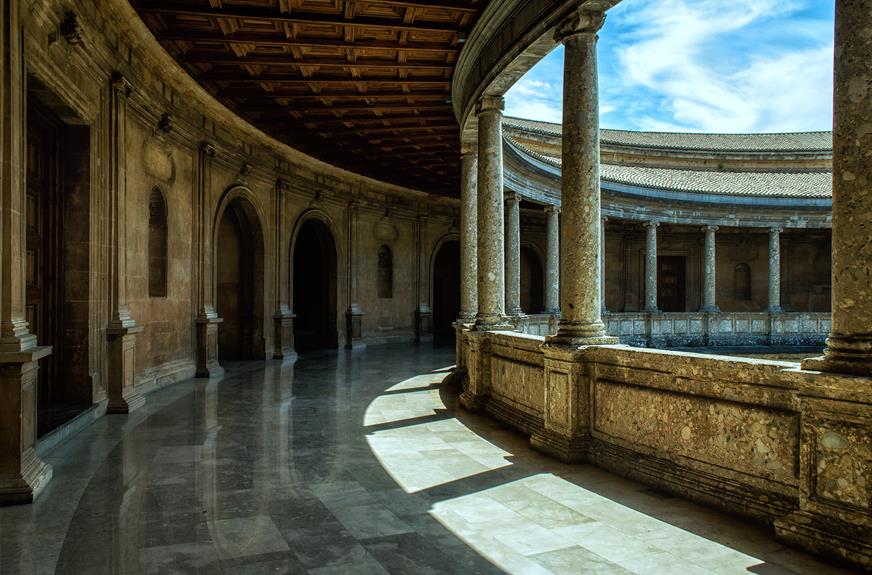
As a seasoned traveler, I've discovered that some destinations hold hidden historical gems just waiting to be explored. And when it comes to Spain, you won't be disappointed. From ancient Roman ruins to majestic medieval castles, this country is a treasure trove of history. UNESCO World Heritage sites, exquisite Moorish palaces, and awe-inspiring cathedrals will transport you back in time. So pack your bags and join me on a journey through Spain's must-see historical wonders.
Key Takeaways
Table of Contents
- Tarraco in Tarragona and Segóbriga Archaeological Park offer well-preserved Roman ruins that provide insight into Roman life.
- Spain boasts medieval castles and fortresses that showcase the country's past, with remarkable preservation and defensive strategies.
- Spain is home to several UNESCO World Heritage Sites, including the iconic Alhambra in Granada and Sagrada Familia in Barcelona.
- Moorish palaces and architecture in Spain, such as Alhambra and Mezquita de Córdoba, exhibit exquisite craftsmanship and Islamic influence.
Roman Ruins in Spain
As a traveler in Spain, I was captivated by the stunning Roman ruins scattered throughout the country. Ancient Roman cities and Roman amphitheaters are among the most impressive historical sites in Spain. One of the most famous ancient Roman cities is Tarraco, located in Tarragona. Walking through its well-preserved ruins, I couldn't help but imagine what life was like during Roman times. The amphitheater in Tarraco is particularly remarkable, with its grand size and intricate architectural details. Another notable Roman ruin is the Segóbriga Archaeological Park, which boasts an impressive amphitheater that once held gladiator fights. Exploring these ruins allowed me to immerse myself in the rich history and cultural heritage of Spain, making my trip truly unforgettable.
Medieval Castles and Fortresses
One highlight of my trip to Spain was exploring the medieval castles and fortresses that dot the countryside. These architectural marvels provide a glimpse into the rich history and strategic importance of Spain's past. What impressed me the most was the remarkable preservation of these medieval fortresses. From the towering walls to the intricate stone carvings, it felt like stepping back in time. The defensive strategies employed by these castles were also fascinating. I learned that the castles were often built on hilltops or near rivers to maximize their defensive capabilities. Moats, drawbridges, and thick walls were common features used to protect these fortresses from enemy attacks. Visiting these medieval castles and fortresses allowed me to appreciate the ingenuity and resilience of the people who built and defended them.
UNESCO World Heritage Sites
Continuing my exploration of Spain's historical gems, I was captivated by the UNESCO World Heritage Sites that showcased the country's cultural and natural wonders. These sites are not only extraordinary, but they also represent Spain's commitment to preserving its rich heritage. The UNESCO World Heritage Sites in Spain include iconic landmarks such as the Alhambra in Granada, the Sagrada Familia in Barcelona, and the historic city of Toledo. These sites are meticulously maintained and protected through ongoing preservation efforts. The Spanish government, along with local communities and organizations, invests significant resources to ensure the conservation and sustainability of these sites for future generations. The UNESCO World Heritage Sites in Spain are a testament to the country's deep-rooted history and its dedication to safeguarding its cultural and natural treasures.
Moorish Palaces and Architecture
I was enthralled by the exquisite Moorish palaces and architecture I encountered during my journey through Spain. The Islamic influence in Spanish architecture is truly remarkable and can be seen in iconic landmarks such as the Alhambra and the Mezquita de Córdoba. The Alhambra, located in Granada, is a stunning example of Moorish architecture with its intricate carvings, beautiful tilework, and lush gardens. The Mezquita de Córdoba, on the other hand, is a unique blend of Islamic and Christian styles. Its famous horseshoe arches and stunning prayer hall showcase the rich history and cultural fusion of Spain. Exploring these Moorish palaces allowed me to appreciate the incredible craftsmanship and ingenuity of the Islamic architects who left their mark on Spanish history.
Historical Cathedrals and Churches
As I delved further into Spain's rich history, I couldn't help but be captivated by the grandeur and architectural magnificence of its historical cathedrals and churches. These iconic structures showcase the country's deep religious heritage and are a testament to the skill and craftsmanship of the time. Some of the highlights of Gothic architecture can be found in Spain, with towering spires and intricate stone carvings that leave visitors in awe. Additionally, Spain is home to famous pilgrimage sites, such as the Santiago de Compostela Cathedral in Galicia, which attracts millions of pilgrims each year. The Cathedral of Seville, with its stunning Giralda bell tower, and the breathtaking Sagrada Familia in Barcelona are also must-see landmarks for any traveler seeking to explore Spain's historical treasures.
Frequently Asked Questions
What Is the Best Time of Year to Visit Spain's Roman Ruins?
The best time to visit Spain's Roman ruins is during the spring or fall. I highly recommend guided tours to fully explore these historical gems, along with the medieval castles and fortresses.
Are There Any Guided Tours Available for Visitors to Explore the Medieval Castles and Fortresses in Spain?
Yes, there are guided tours available for castle exploration in Spain. They offer a fascinating glimpse into the rich history of these medieval fortresses. It's a must-do experience for any traveler.
How Many UNESCO World Heritage Sites Are There in Spain, and Which Ones Are the Most Popular?
In Spain, there are 48 UNESCO World Heritage sites. Some popular ones include the Alhambra in Granada and the Sagrada Familia in Barcelona. To make the most of your visit, explore the best hidden gems in these historical landmarks.
Can Visitors Enter and Explore the Interior of the Moorish Palaces in Spain, or Are They Only Accessible From the Outside?
Yes, visitors can enter and explore the interior of the Moorish palaces in Spain. It's not just about the exterior beauty; there are hidden gems inside these palaces that are worth discovering.
Are There Any Historical Cathedrals or Churches in Spain That Have Been Converted Into Museums or Art Galleries?
Yes, there are historical cathedrals in Spain that have been converted into famous art galleries. It's fascinating to see the blend of religious and artistic history in these unique spaces.




Leave a Reply
You must be logged in to post a comment.